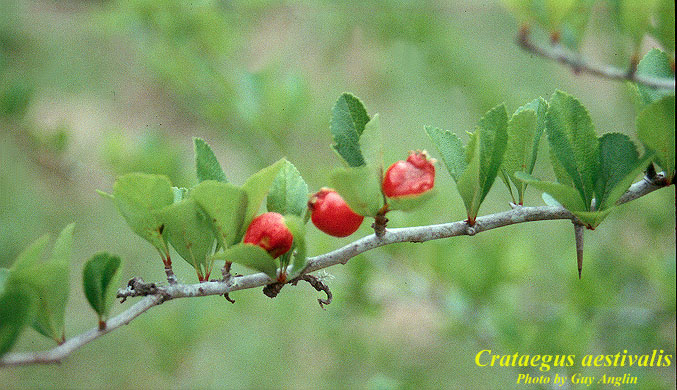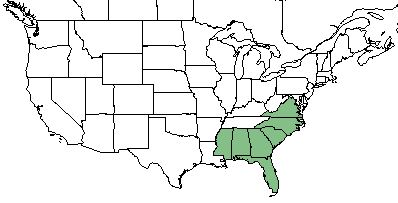Crataegus aestivalis
Common name: May Hawthorn[1]; Mayhaw; Eastern Mayhaw[2]
| Crataegus aestivalis | |
|---|---|

| |
| Photo by the Atlas of Florida Plants Database | |
| Scientific classification | |
| Kingdom: | Plantae |
| Division: | Magnoliophyta - Flowering plants |
| Class: | Magnoliopsida - Dicots |
| Order: | Rosales |
| Family: | Rosaceae |
| Genus: | Crataegus aestivalis |
| Species: | C. aestivalis |
| Binomial name | |
| Crataegus aestivalis Walter | |

| |
| Natural range of Crataegus aestivalis from USDA NRCS Plants Database. | |
Contents
Taxonomic Notes
Synonyms: none[2]
Varieties: none[2]
Description
C. aestivalis is a perennial tree/shrub of the Rosaceae family native to North America.[1] Generally, it is a small tree that is round-topped and reaches heights of 30 feet. It has dark green leaves that are simple and alternately arranged. The flowers are white and grow either singularly or in a cluster of 2 or 3. Fruit is a red and fleshy pome, and twigs are gray to brown with spines.[3]
Distribution
C. aestivalis is common in the southeastern corner of the United States, from Mississippi to Virginia.[1]
Ecology
Habitat
C. aestivalis is most often found in swamp forests, generally where flooded for much of the year, often flowering and fruiting while standing in water, and occasionally growing as groves or stands in ‘mayhaw flats’.[4] It is listed as an obligate wetland species, which means it occurs almost always in wetlands,[1] but it is also often found in deciduous woods.[5] The species prefers full sun, but it can also tolerate partial shade, and can be found on a variety of soil types, preferring slightly acidic and well-drained soils while tolerating either drought conditions or wet soil. It is also quite tolerant of air pollution.[3]
Associated species include Taxodium distichum, Nyssa aquatica, Nyssa biflora, Planera aquatica, and Quercus virginiana.[4][5]
Phenology
C. aestivalis has been observed to flower in February, March, and May. [6] As well, fruiting commonly occurs in May.[3]
Seed bank and germination
For propagation, C. aestivalis seeds will not germinate until they are overwintered. Acid stratification with warm stratification and chilling is also needed for successful germination.[3]
Fire ecology
C. aestivalis is not fire resistant, and has a low fire tolerance.[1]
Herbivory and toxicology
C. aestivalis is highly palatable to browsing animals, not highly palatable to grazing animals, and not palatable to humans.[1] The plant provides nesting as well as cover for small birds, which also eat the fruit. White tailed deer are also known to browse on the young stems and leaves.
Diseases and parasites
Mayhaw is vulnerable to diseases and insects that affect other pome fruit species. These include insects like the hawthorn lace bug, the roundheaded appletree borer, leafmines, mealy bugs, and diseases like fire-blight, cedar quince blight, cedar-hawthron blight, and fruit rot.[3] However, pests and diseases rarely affect Mayhaw.[7]
Conservation, cultivation, and restoration
Pruning annually to open up the tree canopy increases the fruit production of C. aestivalis, and sucker stems as well as weak branches on the plant should be removed during this time period.[3] Two cultivars of C. aestivalis include Lori and Linsey which vary with fruit development. As well, this species can be used for erosion control efforts for stream-bank and shelter belts stabilization.[3]
Cultural use
The fruit can be used for pies, preserves, jelly, and also dried for later use.[4][3] The wood of this plant can be used to make tool handles and mallets, and the plant can be used medicinally as a tea for high blood pressure treatment in herbal folk medicine.[3] It is also a plant that is of special value to native bees.[8]
Photo Gallery
References and notes
- ↑ 1.0 1.1 1.2 1.3 1.4 1.5 USDA Plant Database https://plants.usda.gov/core/profile?symbol=CRAE
- ↑ 2.0 2.1 2.2 Weakley, A.S. 2020. Flora of the Southeastern United States. Edition of 20 October 2020. University of North Carolina at Chapel Hill, Chapel Hill, North Carolina.
- ↑ 3.0 3.1 3.2 3.3 3.4 3.5 3.6 3.7 3.8 Woody, Michael L. 2012. Plant fact sheet for May Hawthorn (Crataegus aestivalis). USDA-Natural Resources Conservation Service, East Texas Plant Material Center. Nacogdoches, Texas, 75964.
- ↑ 4.0 4.1 4.2 Weakley, A. S. (2015). Flora of the Southern and Mid-Atlantic States. Chapel Hill, NC, University of North Carolina Herbarium.
- ↑ 5.0 5.1 URL: http://herbarium.bio.fsu.edu. Last accessed: June 2018. Collectors: Robert K. Godfrey, Angus Gholson, H. Kurz, Sidney McDaniel, R.A. Norris, Wilson Baker, Cecil R. Slaughter, Palmer Kinsler, Edith Ellen Lee-Smith. States and counties: Gadsden County Florida, Jackson County Florida, Leon County Florida, Flagler County Florida, Lafayette County Florida, Wakulla County Florida, Atkinson County Georgia, Early County Georgia, Thomas County Georgia, Baker County Florida, Bradford County Florida.
- ↑ Nelson, G. PanFlora: Plant data for the eastern United States with emphasis on the Southeastern Coastal Plains, Florida, and the Florida Panhandle. www.gilnelson.com/PanFlora/ Accessed: 18 MAY 2018
- ↑ Lorenzo, Alfredo B. (2006). Plant Guide: May Hawthorn Cratageus aestivalis. N.R.C.S. United States Department of Agriculture. Baton Rouge, LA.
- ↑ [[1]] Lady Bird Johnson Wildflower Center. Accessed: April 22, 2019